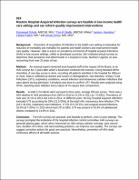| dc.identifier.citation | Ochola, E., Okello, T. R., Kansiime, J., Praticò, L., & Greco, D. (2014, December). 919Routine Hospital Acquired Infection surveys are feasible in low income health care settings and can inform quality improvement interventions. In Open Forum Infectious Diseases (Vol. 1, No. Suppl 1, p. S266). Oxford University Press. | en_US |
| dc.description.abstract | Background. Prevention of acquisition of infection in the health care setting is imperative for reduction in morbidity and mortality for patients and health workers and improvement health care quality. However, data is scarce on prevalence and trends of hospital acquired infections (HAI) in low income settings, unlike in developed countries. We instituted annual surveys to determine HAI prevalence and determinants in a hospital in Gulu, Northern Uganda, an area recovering from over 20 years of war.
Methods. An external expert mentored local hospital staff at the request of the Board, to do HAI surveys for 2 years after which a local team continues the exercise. Using standard WHO checklists. A one-day survey is done, recruiting all patients admitted in the hospital for 48hours or more. Data is collected by doctors and nurses on demographics, new diarrhea, Urinary Tract Infections (UTI), respiratory conditions, wound infection and intravenous catheter infections that were absent during admission. Urinalysis was done to confirm UTI. Results were analysed using SPSS, reporting basic statistics and p values of chi square tests comparisons.
Results. A total 1174 clients were surveyed in four years, average 293 per survey. There was a 56% decline in HAI prevalence from 28% in 2010 to 14.2% in 2011 (p < 0.0001). Prevalence of HAI was 15.1% in 2013 and 14% in 2014. In different years, the key hospital acquired infections included UTI accounting for 39% (21.5-55%) of the total HAI, intravenous line infection 27% (18.2-30.4%), respiratory tract infections, 17.5% (5.5-25.5%), and surgical wound infections, 16.0% (8.7-20%). In 2013 which had UTI at 58%, UTI was present in 53.3% of catheterized clients, compared to 14.8% in 2011.
Conclusion. The HAI surveys are practical, and feasible to perform, even in poor settings. The surveys prompted the institution of the hospital infection control committee. HAI surveys can generate glaring gaps, which when intervened on, like urinary catheter overstay, poor wound care, duration of iv lines, and hand washing practices, can improve care quality. The surveys can suggest corrective actions for good care practices. Nevertheless, prevention of HAI needs continuous efforts of all health workers. | en_US |

